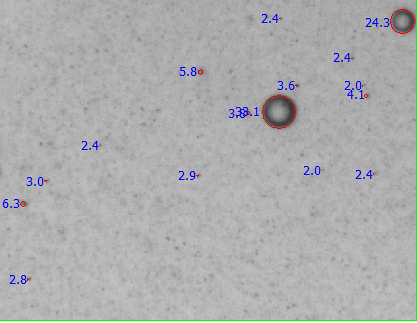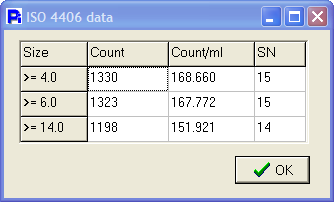APPLICATION EXAMPLE: Oil Contaminants
The challenge
Early detection of wear particles in lubricating and hydraulic fluids is critical to having a proper predictive maintenance program. It is this early detection and identification of wear particles that permits the extension of engine life and can minimize down-time of equipment. The challenge is to count the number of contaminant particles between specified size ranges, and to classify them into several types.
| Applicable measures |
Measure
|
Range of acceptance
3 - 500 microns 0 - 1.00 0 - 1.00 2.0 - 100 microns 5.0 - 100 microns 1.0 - 50.0 |
Typical image
 |
Image showing ECAD micron sizes. Calibration is 0.62 microns/pixel. The large circles are water droplets. |
Notes
ISO 4406 Standard for Oil Cleanliness
The ISO 4406 standard was established in 1987 as a method of coding the level of particle contamination of hydraulic fluids. The most recent revision of
the standard, 1999, has been changed to account for the use of a different calibration standard for
optical automatic particle counters. The sizes to report now are specified as ≥ 4µm, ≥ 6µm, and ≥ 14µm. After the counts for these three sizes
are determined, they are summarized in a kind of shorthand known as Scale Numbers:
ISO Code 17 / 15 / 12
The first of the 3 numbers relates to particles ≥ 4µm, and is a code indicating the approximate count:
Scale Number 17 means that the count (expressed as a concentration) was between 640 particles / ml of fluid and 1300 particles / ml of fluid.
The second scale number relates to particles ≥ 6µm. In this case, the value 15 is indicative of a count between 160 particles / ml and 320 particles / ml.
The third scale number codes the amount of particles ≥ 14µm in size. A value of 12 indicates the count was between 20 and 40 particles / ml.
The ISO 4406 standard lists scale numbers that code a wide range of possible particle concentrations.
Results
 |
The three 4406 concentrations are shown in the Scale Number shorthand as 15 / 15 / 14. |
